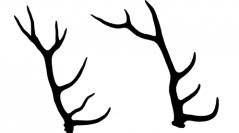

 Anthropozoologica
60 (11) - Pages 143-163
Anthropozoologica
60 (11) - Pages 143-163Deer represent a distinctive family of ruminant herbivores that have evolved a flexible and opportunistic ecological and evolutionary strategy, enabling them to grow luxurious and resource-demanding antlers that are shed annually. The family Cervidae ranks among the most diverse modern taxonomic groups of herbivores, with even greater diversity in the geological past. This ecological flexibility and opportunism align deer closely with hominins. The relationship between cervids and hominins was crucial for hominin survival during glaciation phases and likely played a role in the colonization of the New World by Paleolithic humans. Studies on the taxonomy and systematics of fossil cervids continue to yield new discoveries and insights. Recent research has revealed that the natural history of the genus Cervus in Europe is more complex than previously thought. We suggest that earliest representative of the genus is the small-sized Cervus nestii (Azzaroli, 1947) n. comb. from the Early Pleistocene of Italy, characterized by simple four-pointed antlers lacking a bez tine. The onset of the Middle Pleistocene saw the emergence of the large-sized red deer, with subspecies exhibiting antlers featuring a bez tine but no crown, known as Cervus elaphus acoronatus Beninde, 1937. Subsequently, approximately 400 000 years ago, the “modern” Cervus elaphus Linnaeus, 1758 emerged, displaying high plasticity, diversification, and giving rise to several subspecies during the Late Pleistocene. Our recent revisions at a European scale have uncovered the presence of the wapiti, Cervus canadensis Erxleben, 1777, a species currently inhabiting North America and Asia. From Crimea to Sweden, several subspecies previously attributed to the red deer have been reinterpreted and associated with the wapiti.
Cervidae, morphology, Pleistocene biodiversity, Holocene biodiversity.